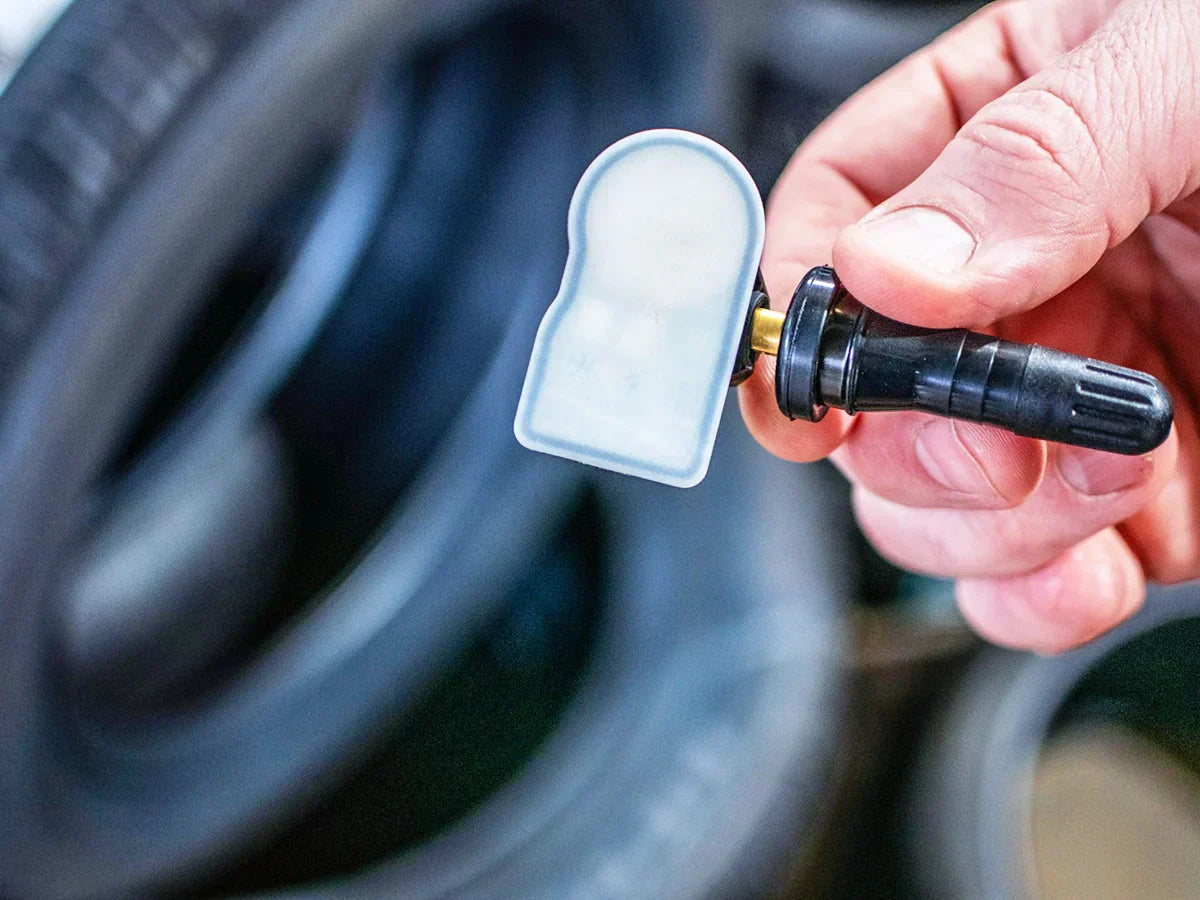
Main content:
The tire pressure sensor battery is the heart of TPMS, powering sensors that provide real-time tire pressure and temperature monitoring. Understanding battery types, lifespan factors, failure signs, and maintenance strategies can prevent unexpected sensor failures. This guide explores direct and indirect TPMS, battery technologies, and practical tips to extend battery life, ensuring long-term reliability and safer driving.
What is a Tire Pressure Sensor?
A tire pressure sensor is a device that monitors the air pressure inside a tire in real time. It typically consists of a pressure sensor, a temperature sensor, and a wireless transmitter module. The sensor converts the detected pressure and temperature data into electrical signals, which are then transmitted wirelessly to a receiver inside the vehicle, ultimately displaying the tire pressure and temperature information on the dashboard.
Tire pressure sensors (TPMS) operate primarily on the piezoelectric effect. Therefore, the sensor is only effective when the tires are fully inflated. When the pressure inside the tire changes, the piezoelectric material within the sensor generates an electrical charge, producing an electrical signal. This signal changes with the pressure, enabling real-time monitoring of the tire's internal pressure.
TPMS Battery Basics and Working Principle

Depending on their operating method, TPMS can be divided into two types: direct and indirect.
Direct TPMS directly measures tire pressure and temperature using sensors within each tire and is powered by an internal battery.
Indirect TPMS calculates tire pressure changes indirectly through ABS or wheel speed sensors, requiring no separate battery power.
In a direct system, the battery provides energy to the electronic components and wireless transmission module within the sensor. The sensor converts the detected pressure and temperature data into an electrical signal and transmits it wirelessly (RF) to the vehicle's electronic control unit (ECU), ultimately displaying the tire pressure and temperature information on the dashboard.
The working principle of tire pressure sensors relies mainly on the piezoelectric effect. Therefore, to determine if the sensor is functioning correctly, it must be tested with the tires fully inflated. When the pressure inside a tire changes, the piezoelectric material within the pressure sensor generates an electrical charge, thus forming an electrical signal. This signal changes with the pressure, enabling real-time monitoring of the tire's internal pressure.
Furthermore, the performance of the TPMS battery directly determines the sensor's reliability and lifespan. Most TPMS batteries use 3V lithium-ion or lithium thionyl chloride (Li-SOCl₂) batteries, capable of stable operation in environments ranging from -40℃ to +125℃. When the battery is depleted, the sensor stops transmitting signals, causing the TPMS indicator light on the dashboard to flash or remain constantly lit, at which point the entire sensor assembly typically needs to be replaced.
Tire Pressure Sensor Battery Types
Currently, the mainstream tire pressure sensor battery is the 3V lithium-ion battery. This type of battery features high energy density, low self-discharge rate, and good high-temperature resistance, providing a stable power supply for the sensor's wireless transmission module and pressure detection circuitry.
Some earlier or older sensor models also use 1.25V NiMH batteries. While these types of batteries are less expensive, their capacity is relatively small, and their stability under extreme temperatures is inferior to lithium batteries, leading to their gradual replacement by the latter.
For high-end or industrial-grade TPMS sensors, lithium thionyl chloride (LiTCH) batteries, which offer superior performance, are used. These batteries are renowned for their exceptional energy density and ultra-long lifespan, maintaining stable operation even in extreme environments.
Their operating temperature range is -40°C to 125°C, making them particularly suitable for heavy vehicles, construction machinery, or areas with frequent high-temperature road conditions. Thanks to their low self-discharge rate and high withstand voltage, these batteries typically have a lifespan exceeding 10 years.
Battery Packaging and Structural Design

The batteries in tire pressure sensors are usually encapsulated in a robust plastic housing to ensure stable power supply during long-term operation, continuous vibration, and high-temperature environments. To further enhance shock and moisture resistance, a special potting compound is used for sealing and fixation inside the sensor.
This potting material effectively prevents vibration damage to the circuitry and also blocks moisture and dust from entering the battery compartment, thus preventing corrosion of internal metal components. This design greatly improves the sensor's reliability, allowing it to remain functional even after hundreds of thousands of kilometers of driving.
However, a side effect of the potting structure is that the battery is almost impossible to replace individually. Once the battery is depleted, removing the potting layer and resealing it is not only complex but also damages the sensor's waterproof and shockproof structure. Therefore, in most cases, when the battery reaches the end of its lifespan, the entire tire pressure sensor assembly needs to be replaced, rather than just the battery.
A qualified TPMS battery must not only have a long lifespan and stable discharge characteristics but also maintain stable voltage output under different temperature environments. Excessively high temperatures accelerate chemical reactions and shorten battery life; while low temperatures reduce electrolyte activity, leading to insufficient voltage.
TPMS Battery Lifespan and Influencing Factors

The battery in a tire pressure monitoring system (TPMS) is a critical component for maintaining the long-term stable operation of the sensor. Because it is usually encapsulated inside the sensor and cannot be replaced individually, the battery life directly determines the entire lifespan of the sensor.
Average Lifespan
TPMS batteries typically have a lifespan of 5–12 years, with an average of about 7 years. The specific lifespan depends on the usage environment, vehicle usage frequency, and the battery's chemical characteristics. For everyday passenger vehicles, if the sensor design is reasonable and environmental conditions are favorable, it can usually operate stably for 6–8 years.
Key Influencing Factors
Driving Frequency
When the vehicle is in motion, the sensors continuously collect tire pressure and temperature data and frequently transmit them to the ECU via wireless signals, resulting in faster power consumption. During high-speed, stable driving or prolonged periods of stationary operation, the data transmission frequency decreases, and power consumption correspondingly decreases.
Ambient Temperature
Ambient temperature is a crucial factor affecting battery lifespan. High temperatures accelerate internal chemical reactions, increasing the rate of power loss; conversely, low temperatures slow down chemical reactions, which can actually help extend battery life.
Battery Type and Capacity
The battery's chemical system and capacity directly determine its driving range.
Most standard TPMS sensors use 3V lithium-ion batteries.
Some high-end or industrial-grade sensors use lithium thionyl chloride batteries, which offer higher energy density and a wider temperature range (-40℃ to 125℃), significantly extending sensor lifespan.
Sensor Design
Newer generation TPMS sensors typically feature low-power ASIC chips, effectively reducing power consumption while maintaining monitoring accuracy, thus extending battery life.
Installation Quality
If the sensor is not securely installed, prolonged exposure to vibration or impact may cause loose battery connections or abnormal power consumption. Proper installation effectively reduces energy loss.
How to Diagnose TPMS Battery Failure

The TPMS warning light flashes for 60–90 seconds and then stays on. This is a typical indication that the system has detected an abnormal sensor signal or low battery power.
If the diagnostic equipment cannot detect the sensor signal, the sensor may have stopped transmitting data.
Abnormal or intermittent barometric pressure readings. Intermittent signal interruptions may also be caused by low battery voltage.
Professional TPMS tools can quickly detect the communication status, frequency, and battery health of each tire sensor.
Some advanced testing equipment can directly display the sensor's battery voltage or estimated remaining lifespan, helping technicians determine if sensor replacement is necessary.
Strategies for Extending TPMS Battery Life

Installation and Maintenance
Proper installation and routine maintenance of TPMS sensors are fundamental to extending battery life. Sensors must be securely installed to prevent circuit and battery malfunctions caused by vehicle vibrations or road impacts. Regularly check sensors for physical damage, corrosion, or loosening, and address any issues promptly to reduce unnecessary battery consumption and ensure long-term stable sensor operation.
Temperature Management
Ambient temperature significantly impacts TPMS battery life. High temperatures accelerate internal chemical reactions, leading to rapid power consumption; low temperatures may temporarily reduce battery voltage, affecting sensor performance.
Therefore, avoid prolonged exposure of tires to extreme high or low temperatures and use high-quality batteries with a wide temperature range, such as Tadiran lithium thionyl chloride batteries, which can operate stably in environments from -40℃ to 125℃, improving sensor reliability.
Transmission Frequency Optimization
TPMS sensors consume power each time they transmit data wirelessly. Therefore, optimizing the data transmission frequency can effectively extend battery life. Reducing unnecessary frequent transmissions, or adjusting the transmission interval through system software, can reduce battery power consumption while maintaining tire pressure monitoring accuracy, thereby extending the overall lifespan of the sensor.
Regular Calibration and Software Updates
Regularly calibrating the sensor ensures accurate tire pressure readings, avoids frequent data transmissions due to false alarms, and reduces battery consumption. Simultaneously, keeping the sensor and vehicle ECU software or firmware up-to-date optimizes data processing logic and power management, further improving battery efficiency and TPMS system stability.
Seasonal Adjustment
Adjusting the transmission strategy according to different seasons also helps extend battery life. In winter, when air pressure fluctuates greatly, the data transmission frequency can be moderately increased to ensure monitoring accuracy; in summer, when air pressure is relatively stable, the transmission frequency can be appropriately reduced to decrease battery load. Seasonal optimization can extend the lifespan of the TPMS battery while ensuring safe monitoring.
TPMS Battery and Brand Selection
Choosing a high-quality battery is key to ensuring the long-term reliable operation of the TPMS. Lithium thionyl chloride (LiTHC) batteries are recommended. These batteries have a lifespan of over 10 years, a wide temperature range, and good vibration resistance.
Brands like Tadiran, Panasonic, and Maxell are representative in the industrial and automotive sectors, providing stable voltage output and low self-discharge rates. This helps the sensor maintain normal operation at high speeds or in extreme temperatures, thus extending the reliability and lifespan of the entire TPMS system.
Conclusion
Maintaining a healthy tire pressure sensor battery is crucial for accurate tire monitoring and vehicle safety. Choosing high-quality batteries, proper installation, temperature management, and optimized transmission can significantly extend sensor lifespan. By following these strategies, drivers can reduce maintenance costs, avoid sensor failures, and enjoy consistent TPMS performance, ensuring tires are properly monitored under all conditions.
FAQs
Can batteries be replaced in tire pressure sensors?
Most TPMS batteries are encapsulated inside the sensor and secured with potting compound. Their complex structure and waterproof/shockproof design generally prevent individual replacement. If the battery is depleted, the entire tire pressure sensor assembly usually needs to be replaced to ensure system reliability and safety.
What happens when a tire pressure sensor battery dies?
When the TPMS battery is depleted, the sensor can no longer transmit tire pressure and temperature data. The TPMS indicator light on the vehicle's dashboard will flash or remain constantly lit. Simultaneously, the tire pressure reading may be abnormal or intermittent, indicating that the sensor has failed and needs to be replaced promptly.
What batteries are used in TPMS?
The mainstream TPMS sensor battery is a 3V lithium-ion battery. High-end or industrial-grade sensors also use lithium thionyl chloride batteries, which feature high energy density, low self-discharge rate, and wide operating temperature range. Some older models may use 1.25V NiMH batteries, but their performance and lifespan are relatively limited.
How much does it cost to replace a TPMS sensor battery?
Replacing the battery usually means replacing the entire sensor assembly. The price varies depending on the brand and model, generally ranging from tens to hundreds of dollars. High-end or industrial-grade sensors are more expensive, but offer longer lifespan and more stable performance, reducing maintenance frequency and risk in the long run.















